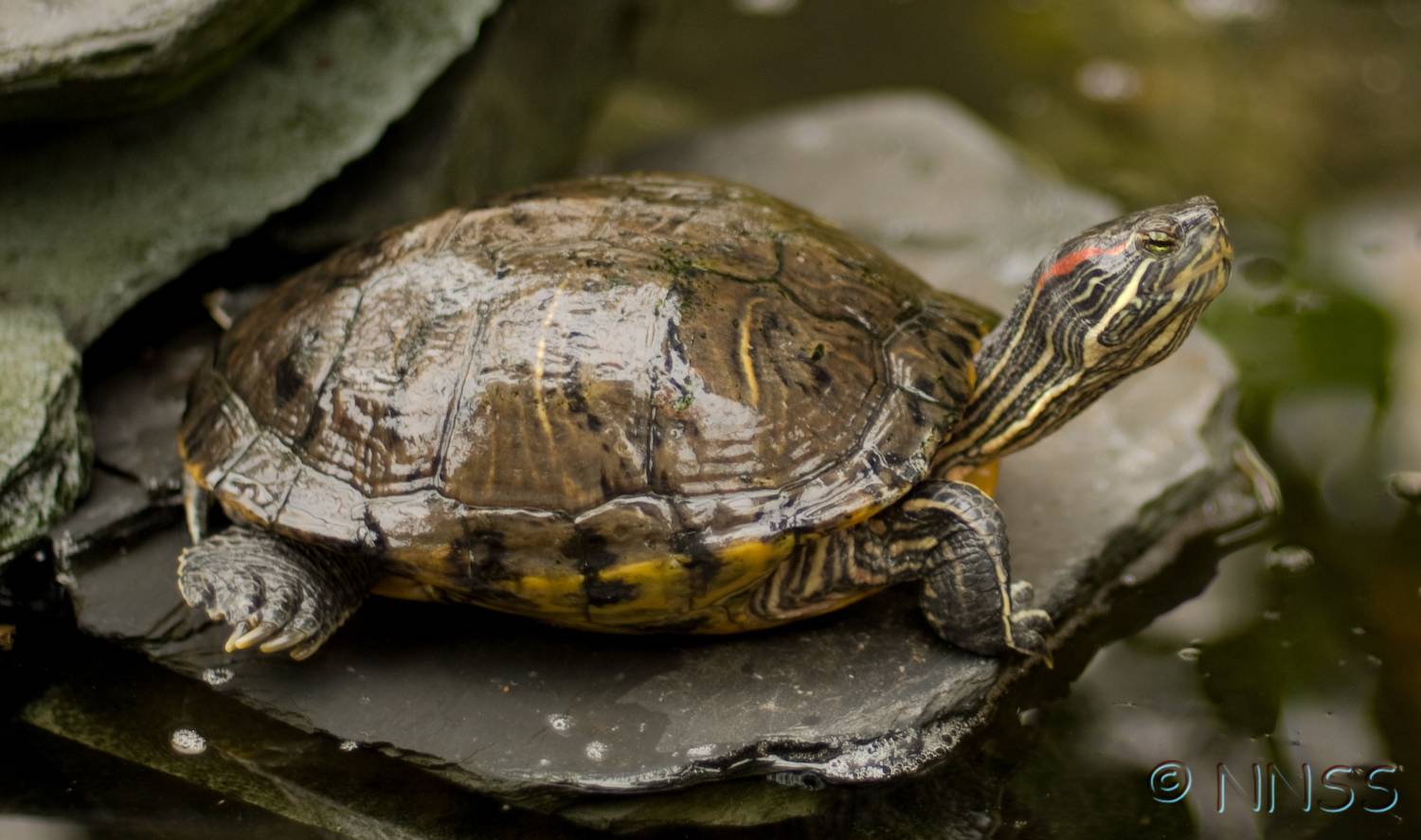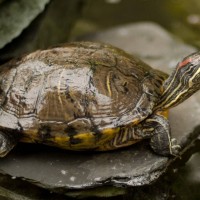
Red-eared Terrapin - Trachemys scripta
Expand and collapse the sections below by clicking on the title or + / - icons.
Short description of Trachemys scripta, Red-eared Terrapin
A terrapin, the shell of which can grow up to 30 cm long but hatchlings measure just a few centimetres. Shell usually dark green to black with greenish or yellowish markings. Limbs, head and neck may be striped with yellow and colourful red or yellow "ears" may be present behind the eye (depending on the "subspecies"). Small juveniles are the most colourful, fading and becoming darker with age. Many similar species and related genera are being kept and may be released.
Impact summary: Trachemys scripta, Red-eared Terrapin
A voracious predator. May impact native aquatic life of all types, including especially amphibians, inverterbrates, fish and possibly even waterfowl.
Habitat summary: Trachemys scripta, Red-eared Terrapin
A variety of water bodies from park ponds to large lakes, typically seen basking on emergent logs or rocks.
Overview table
| Environment | Terrestrial |
|---|---|
| Species status | Non-Native |
| Native range | Mexico, Belize, Colombia, Costa Rica, Guatemala, Honduras, Nicaragua, Panama, El Salvador, Venezuela |
| Functional type | Predator |
| Status in England | Non-Native |
| Status in Scotland | Non-Native |
| Status in Wales | Non-Native |
| Location of first record | |
| Date of first record | Unknown |
Origin
Native to North America (originally the Mississippi basin).
First Record
Earliest records from early twentieth century.
Pathway and Method
A very common pet species, particularly following the TV series "Teenage Mutant Ninja Turtles" in the late 1980s. Huge numbers were imported in the pet trade and many released when they grew large. The species can live several decades and some are known to have survived from the 1980s and 1990s into 2000. This and other terrapins/turtles may still be illegally released throughout GB.
Species Status
Millions of Red-eared Terrapins were exported from the USA and introduced in at least 75 countries globally as a result of the pet trade and turtle-meat industry. They are widely distributed throughout Europe and have successfully reproduced in many European countries including Italy, Spain, Portugal, France and Slovenia. They are widespread and survive well in GB, but are not thought to reproduce in GB due to the colder climate, but there have been cases of (unsuccessful) egg-laying and a juvenile was spotted in 2013 in London.
Dispersal Mechanisms
Capable of dispersal over land for several kilometres but most released animals remain at release site and so do not spread.
Reproduction
Courtship is under water and begins in May. If mating is successful, up to 30 eggs are laid in loose substrate after a few days or weeks, several clutches per year are possible. It is unusual (if not near impossible) for the GB climate to provide the 59-112 days of warm weather leading to hatching. Successful reproduction not recorded in GB but has occurred where introduced further south (e.g. France, Italy).
Known Predators/Herbivores
Not documented for GB but generalist predators may take small animals and (introduced) mink may be adapted to prey on terrapins.
Resistant Stages
None.
Habitat Occupied in GB
May be found anywhere where there's a persistent water body but especially urban parks, lakes, canals and rivers where released - any site with basking spots and a place where the winter can be spent.
May be found anywhere in GB but most records of persistent individuals are from warmer or more southerly areas (e.g. Poole, London Boroughs).
Environmental Impact
The Red-eared Terrapin is a threat to native turtles in Europe by outcompeting them and through the introduction of diseases and non-native helminth parasites. Diseases may also be spread to other aquatic animals. Red-eared terrapins consume any aquatic life they can catch, as well as plants. In some cases, may reduce numbers of invertebrates, fish and waterfowl (nestlings). Specific impacts in GB not documented but likely to be localised.
Health and Social Impact
Can carry diseases (Salmonella) transmissible to humans and domestic animals.
Economic Impact
None known.
Identification
Inns, H. (2009) Britain’s reptiles and amphibians. Wildguides, Old Basing.
Biology, ecology, spread, vectors
Demkowska-Kutrzepa, M., Studzińska, M., Roczeń-Karczmarz, M., Tomczuk, K., Abbas, Z. and Różański, R. (2018) A review of the helminths co-introduced with Trachemys scripta elegans; a threat to European native turtle health, Amphibia-Reptilia 2: 1-13
Martins, B.H., Azevedo, F. and Teixeira, J. (2018) First reproduction report of Trachemys scripta in Portugal Ria Formosa Natural Park, Algarve, Limnetica 37: 61- 67.
Management and impact
Cadi, A. & Joli, P. (2004) Impact of the introduction of the red-eared slider (Trachemys scripta elegans) on survival rates of the European pond turtle (Emys orbicularis). Biodiversity and Conservation, 13, 2511-2518.
Perez-Santigosa N., Diaz-Paniagua C., Hidalgo-Vila, J. (2008) The reproductive ecology of exotic Trachemys scripta elegans in an invaded area of southern Europe. Aquatic Conservation, 18, 1302-1310.
General
van Wilgen, N.J., Gillespie, M.S., Richardson, D.M. & Measey, J. (2018). A taxonomically and geographically constrained information base limits non-native reptile and amphibian risk assessment: a systematic review, Peer J 6: e5850.
https://www.cabi.org/isc/datasheet/61560
http://www.nonnativespecies.org/downloadDocument.cfm?id=60
Spotted this species?
Distribution map
View the Distribution map for Red-eared Terrapin, Trachemys scripta from NBN Atlas
Risk assessment
Risk assessment for Trachemys scripta elegans. See a full list of non-native species Risk assessments.
Legislation
All trachemys scripta subspecies including red-eared slider, yellow-bellied slider, Cumberland slider and common slider are species of Special Concern. Find out more about non-native species legislation.

